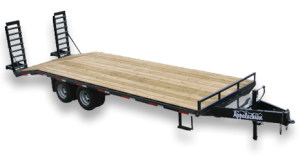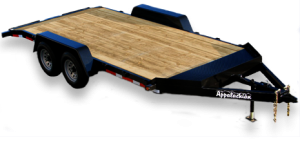A flatbed trailer and a deckover trailer have the similarity of being trailers, but are different in ways that make them suitable for different uses.
Difference Between Flatbed and Deckover Trailers
The main difference is that a standard flatbed trailer has a deck that rests between the wheels, while a deckover trailer’s deck sits over the wheels, offering a larger, unobstructed surface area.
Deckover trailers are ideal for hauling wider and bulkier loads, such as large tractors, industrial machinery, and multiple vehicles. This design makes loading easier with forklifts and accommodates wider items than the space between standard flatbed wheels.
Standard flatbeds, with their lower center of gravity and deck between the wheels, offer better stability for loads that fit within the wheel wells, such as ATVs and cars.
Standard Flatbed Trailer
- Deck Design: The deck is positioned between the wheels, resulting in a lower deck height and improved ground clearance.
- Deck Surface: The usable surface area is limited by the space between the wheel wells.
- Best Use: Hauling items that fit within the wheel wells, such as cars, ATVs, and smaller equipment.
- Considerations: Lower ground clearance makes it best suited for flat, even surfaces.
Benefits of a Flatbed Trailer
The primary benefits of a flatbed trailer are its versatility, high capacity, and ease of loading, which make it ideal for hauling oversized, heavy, or unusually shaped cargo. Because the cargo deck is open, it accommodates freight that would not fit within an enclosed trailer and allows for more flexible loading options.
Versatility
A flatbed’s open design makes it highly adaptable for a wide variety of loads.
- Accommodates diverse cargo: You can haul everything from heavy construction machinery and building materials like lumber and steel beams to large agricultural equipment, vehicles, and even prefabricated structures.
- Flexible dimensions: Without the restriction of walls and a roof, a flatbed can transport oversized and over-dimensional freight, including items longer than the trailer itself (with proper permits and safety equipment).
Loading and Unloading Efficiency
The deck of a flatbed trailer is accessible from all sides, which significantly simplified and speeds up the loading process.
- Multiple access points: Cargo can be loaded and unloaded from the top, sides, and rear using various types of equipment, such as cranes and forklifts.
- No loading dock required: Unlike enclosed trailers, flatbeds can be loaded and unloaded at job sites or other locations without the need for a formal loading dock.
- Reduced delays: For truck drivers, this flexible access can mean less time waiting at busy warehouses or distribution centers.
High Capacity and Durability
Flatbed trailers are engineered to handle demanding and heavy-duty tasks.
- Handles heavy loads: Flatbeds have robust weight capacities, often accommodating freight that weighs up to 48,000 pounds on a standard trailer.
- Resilient construction: They are built with durable materials like steel or aluminum to withstand heavy loads and harsh road conditions.
- Maximizes payload: By accommodating large and heavy items in a single trip, flatbeds can reduce the overall number of trips needed for a project, leading to cost savings.
Cost-Effectiveness
In many scenarios, using a flatbed trailer is a cost-effective choice for both businesses and owner-operators.
- Lower manufacturing costs: The simple, open design requires fewer materials and less labor to build, which can make them cheaper than enclosed trailers.
- High demand, high pay: Flatbed hauling is a specialized service, and drivers are often paid a higher rate per mile compared to those hauling standard dry van loads.
- Maximizes payload efficiency: Hauling more cargo per trip reduces fuel expenses and labor costs.
Deckover Trailer
A deckover trailer’s main characteristic is its flat, wide deck that sits entirely above the wheels, offering maximum usable space for oversized loads and easier side-loading. Other key features include a heavy-duty, reinforced frame for stability and strength, rub rails with stake pockets for secure tie-down points, and enclosed wiring for protection of LED lighting. This design provides greater ground clearance than standard trailers and greater efficiency by allowing for faster loading of wide equipment.
- Trailer Design: The deck extends over the wheels and fenders, providing a completely clear, wide platform.
- Deck Surface: Offers a much larger and wider loading surface area compared to a standard flatbed.
- Best Use: Hauling wide and bulky loads, large machinery, construction materials, pallets, and multiple pieces of equipment that exceed the width of a standard flatbed trailer.
- Considerations: Features higher ground clearance, making it suitable for both flat and rough terrain.
Who is a Deckover Trailer For?
These trailers are best suited for individuals or businesses that frequently transport items that would be difficult to fit or secure on a traditional flatbed trailer. Examples include:
- Construction businesses that move heavy equipment
- Farmers transporting large loads of materials
- Individuals hauling large tractors, mowers, or multiple ATVs
Benefits of a Deckover Trailer
Deckover trailers allow you to use the full width of the trailer, not just what fits between the wheels. This proves especially helpful when you’re hauling a wide load like a large mower deck, utility tractor, or even multiple ATVs or snowmobiles. Be sure to continue keeping an eye on your load capacity.
Maximized Loading Space
The deck sits above the wheels, creating a wide, flat platform that utilizes the full width of the trailer for hauling large or wide equipment, ATVs, and construction materials.
Simplified Loading & Securing
The open-top design and absence of wheel wells allow for easier maneuvering of cargo, such as when using a forklift for pallets or lumber. There are also numerous tie-down points to securely fasten cargo during transit.
Versatility
Deckover trailers are highly versatile and excel in industries like construction and farming, where hauling large, heavy, and bulky items is common.
Increased Ground Clearance
The design provides more ground clearance, which can be beneficial in some hauling scenarios.

